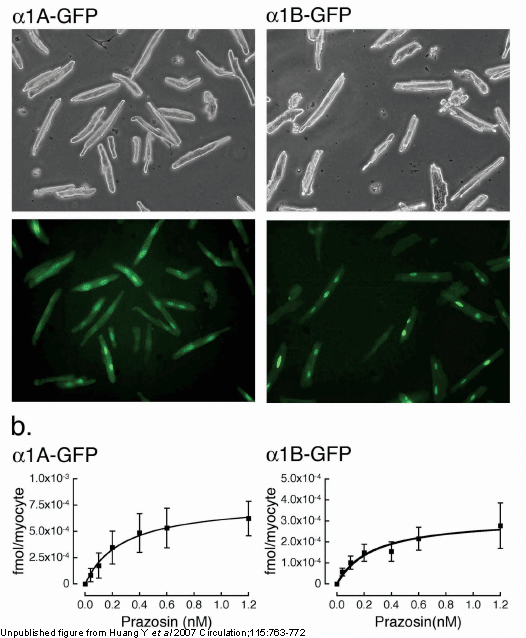The O'Connell Lab
Refuting the Irrefutable Since 2004
α1-Adrenergic Receptors Are Cardio-protective
Clinically, the role of catecholamines and ARs in heart failure is well established and β-AR antagonists, or β-blockers, are indicated in heart failure. However, the notion that blocking all AR signaling in heart failure is beneficial is challenged by several clinical trials. In ALLHAT and V-HeFT, trials that examined the efficacy of α1-blockers in either hypertension or heart failure respectively, α1-blockade failed to show protective effects, and in ALLHAT, α1-blockade increased the risk of heart failure and death.
In mice lacking the two α1-AR subtypes expressed in the heart (α1ABKO mice), we demonstrated that α1-ARs prevent cell death and contractile dysfunction in response to pathologic stress. Subsequently, we identified an α1A-survival-signaling pathway in adult cardiac myocytes, the absence of which could explain (at least partially) the maladaptive response of α1ABKO mice to pathologic stress. Our preliminary data and work from others also demonstrated that α1A-mediated positive inotropy might prevent contractile dysfunction.
In this project, we are testing the hypothesis that cardiac-specific over-expression of the α1A-subtype is sufficient to inhibit cardiac myocyte death and preserve contractile function, thereby attenuating pathologic remodeling and reducing mortality following ischemic injury caused by myocardial infarction. We will determine if prevention of cell death by the α1A-AR is a major protective mechanism preventing pathologic remodeling in the heart. Finally we will determine if prevention of contractile dysfunction by the α1A-AR, or α1A-mediated positive inotropy, is a major protective mechanism preventing pathologic remodeling in the heart.
Lab Publications Relevant to this Project:
-
O'Connell TD, Jensen BC, Baker AJ, Simpson PC. 2013. Cardiac alpha1-adrenergic receptors: novel aspects of expression, signaling mechanisms, physiologic function, and clinical importance. Pharmacol Rev. 66(1):308-33.
-
Huang Y, Wright CD, Kobayashi S, Healy CL, Elgethun M, Cypher A, Liang Q, and O’Connell TD. 2008. GATA4 is a survival factor in adult cardiac myocytes, but is not required for α1A-adrenergic receptor survival signaling. Amer. J. Physiol. Heart Circ. Physiol. 295:H699-707.
-
Huang Y, Wright CD, Merkwan CL, Baye NL, Liang Q, Simpson PC and O’Connell TD. 2007. An α1A-adrenergic-extracellular signal-regulated kinase survival signaling pathway in cardiac myocytes. Circulation. 115: 763-772.
-
O’Connell TD, Swigart PS, Rodrigo MC, Ishizaka S, Joho S, Foster E, Grossman W, and Simpson PC. 2006, α1-Adrenregic receptors prevent a maladaptive response to pressure overload. J. Clin. Invest. 116: 1005-1015.
-
McCloskey DT, O’Connell TD, Simpson PC and Baker AJ. 2003. Abnormal myocardial contraction in α1A- and α1B-adrenoceptor double knockout mice. J. Mol. Cell. Card. 35: 1207-1216.
-
O’Connell TD, Ishizaka S, Nakamura A, Swigart PS, Rodrigo MC, Simpson GL, Cotecchia S, Rokosh DG, Grossman W, Foster E and Simpson PC. 2003. Th α1A/C- and α1B-adrenergic receptors are required for physiological hypertrophy in the double-knockout mouse J. Clin. Invest. 111: 1783-1791.
